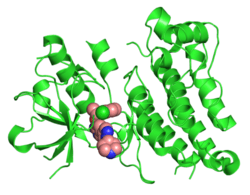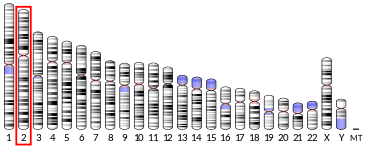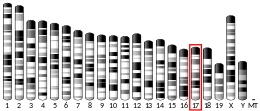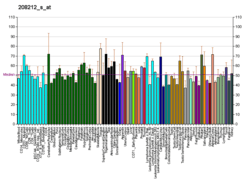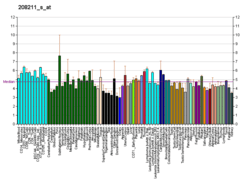Anaplastic lymphoma kinase
Anaplastic lymphoma kinase (ALK) also known as ALK tyrosine kinase receptor or CD246 (cluster of differentiation 246) is an enzyme that in humans is encoded by the ALK gene.[5][6]
Identification
Anaplastic lymphoma kinase (ALK) was originally discovered in 1994[5][7] in anaplastic large-cell lymphoma (ALCL) cells. ALCL is caused by a (2;5)(p23:q35) chromosomal translocation that generates the fusion protein NPM-ALK, in which the kinase domain of ALK is fused to the amino-terminal part of the nucleophosmin (NPM) protein. Dimerization of NPM constitutively activates the ALK kinase domain.[5][7]
The full-length protein ALK was identified in 1997 by two groups.[8][9] The deduced amino acid sequences revealed that ALK was a novel receptor tyrosine kinase (RTK), having an extracellular ligand-binding domain, a transmembrane domain, and an intracellular tyrosine kinase domain.[8][9] While the tyrosine kinase domain of human ALK shares a high degree of similarity with that of the insulin receptor, its extracellular domain is unique among the RTK family in containing two MAM domains (meprin, A5 protein and receptor protein tyrosine phosphatase mu), an LDLa domain (low-density lipoprotein receptor class A) and a glycine-rich region.[9][10] Based on overall homology, ALK is closely related to the leukocyte receptor tyrosine kinase (LTK) and, together with the insulin receptor, forms a subgroup in the RTK superfamily.[8][9] The human ALK gene encodes a protein 1,620 amino acids long with a molecular weight of 180 kDa.[8][9]
Since the original discovery of the receptor in mammals, several orthologs of ALK have been identified: dAlk in the fruit fly (Drosophila melanogaster) in 2001,[10] scd-2 in the nematode (Caenorhabditis elegans) in 2004,[11] and DrAlk in the zebrafish (Danio rerio) in 2013.[12]
The ligands of the human ALK/LTK receptors were identified in 2014:[13][14][15] FAM150A (AUGβ) and FAM150B (AUGα), two small secreted peptides that strongly activate ALK signaling. In invertebrates, ALK-activating ligands are Jelly belly (Jeb) in Drosophila,[16][17] and hesitation behaviour 1 (HEN-1) in C. elegans.[18] No such ligands have been reported yet in zebrafish or other vertebrates.[19]
Mechanism
Following binding of the ligand, the full-length receptor ALK dimerizes, changes conformation, and autoactivates its own kinase domain, which in turn phosphorylates other ALK receptors in trans on specific tyrosine amino acid residues. ALK phosphorylated residues serve as binding sites for the recruitment of several adaptor and other cellular proteins, such as GRB2,[20] IRS1,[20][21] Shc,[20][22] Src,[23] FRS2,[22] PTPN11/Shp2,[24] PLCγ,[25][21] PI3K,[26][21] and NF1.[27] Other reported downstream ALK targets include FOXO3a,[28] CDKN1B/p27kip,[29] cyclin D2, NIPA,[30][31] RAC1,[32] CDC42,[33] p130CAS,[34] SHP1,[35] and PIKFYVE.[36]
Phosphorylated ALK activates multiple downstream signal transduction pathways, including MAPK-ERK, PI3K-AKT, PLCγ, CRKL-C3G, and JAK-STAT.[37][19]
Function
The receptor ALK plays a pivotal role in cellular communication and in the normal development and function of the nervous system.[6] This observation is based on the extensive expression of ALK messenger RNA (mRNA) throughout the nervous system during mouse embryogenesis.[8][9][38] In vitro functional studies have demonstrated that ALK activation promotes neuronal differentiation of PC12[39][40][41][22] or neuroblastoma cell lines.[21]
ALK is critical for embryonic development in Drosophila. Flies lacking the receptor die due to failure of founder cell specification in embryonic visceral muscle.[16][17][42] However, while ALK knockout mice exhibit defects in neurogenesis and testosterone production, they remain viable, suggesting that ALK is not critical to their developmental processes.[43][44][45]
ALK regulates retinal axon targeting,[46] growth and size,[27][47] synapse development[11] at the neuromuscular junction,[48][49] behavioral responses to ethanol,[50][51][52][53] and sleep.[54] It restricts and constrains learning and long-term memory [27][55][44] and small-molecule inhibitors of the ALK receptor can improve learning[27] and long-term memory[55] and extend healthy lifespan.[56] ALK is also a candidate thinness gene, as its genetic deletion leads to resistance to diet- and leptin-mutation-induced obesity.[57][N 1]
Pathology
The ALK gene can be oncogenic in three ways – by forming a fusion gene with any of several other genes, by gaining additional gene copies or with mutations of the actual DNA code for the gene itself.[37][19]
Anaplastic large-cell lymphoma
The 2;5 chromosomal translocation is associated with approximately 60% anaplastic large-cell lymphomas (ALCLs). The translocation creates a fusion gene consisting of the ALK (anaplastic lymphoma kinase) gene and the nucleophosmin (NPM) gene: the 3' half of ALK, derived from chromosome 2 and coding for the catalytic domain, is fused to the 5' portion of NPM from chromosome 5. The product of the NPM-ALK fusion gene is oncogenic. In a smaller fraction of ALCL patients, the 3' half of ALK is fused to the 5' sequence of TPM3 gene, encoding for tropomyosin 3. In rare cases, ALK is fused to other 5' fusion partners, such as TFG, ATIC, CLTC1, TPM4, MSN, ALO17, MYH9.[58]
Adenocarcinoma of the lung
The EML4-ALK fusion gene is responsible for approximately 3-5% of non-small-cell lung cancer (NSCLC). The vast majority of cases are adenocarcinomas. The standard test used to detect this gene in tumor samples is fluorescence in situ hybridization (FISH) by a US FDA approved kit. Recently Roche Ventana obtained approval in China and European Union countries to test this mutation by immunohistochemistry.[59] Other techniques like reverse-transcriptase PCR (RT-PCR) can also be used to detect lung cancers with an ALK gene fusion but not recommended. ALK lung cancers are found in patients of all ages, although on average these patients tend to be younger. ALK lung cancers are more common in light cigarette smokers or nonsmokers, but a significant number of patients with this disease are current or former cigarette smokers. EML4-ALK-rearrangement in NSCLC is exclusive and not found in EGFR- or KRAS-mutated tumors.[60]
Gene rearrangements and overexpression in other tumours
- Familial cases of neuroblastoma[61]
- Inflammatory myofibroblastic tumor[62][63]
- Adult[64][65] and pediatric[66][67] renal cell carcinomas
- Esophageal squamous cell carcinoma[68][69]
- Breast cancer,[70] notably the inflammatory subtype[71]
- Colonic adenocarcinoma[70]
- Glioblastoma multiforme[72][73]
- Anaplastic thyroid cancer[74]
ALK inhibitors
- Xalkori (crizotinib), produced by Pfizer, was approved by the FDA for treatment of late stage lung cancer on August 26, 2011.[75] Early results of an initial Phase I trial with 82 patients with ALK induced lung cancer showed an overall response rate of 57%, a disease control rate at 8 weeks of 87% and progression free survival at 6 months of 72%.
- Ceritinib was approved by the FDA in April 2014 for the treatment of patients with anaplastic lymphoma kinase (ALK)-positive metastatic non-small cell lung cancer (NSCLC) who have progressed on or are intolerant to crizotinib.[76]
- Entrectinib (RXDX-101) is a selective tyrosine kinase inhibitor developed by Ignyta, Inc., with specificity, at low nanomolar concentrations, for all of three Trk proteins (encoded by the three NTRK genes, respectively) as well as the ROS1, and ALK receptor tyrosine kinases. An open label, multicenter, global phase 2 clinical trial called STARTRK-2 is currently underway to test the drug in patients with ROS1/NTRK/ALK gene rearrangements.
See also
References and Notes
References
- GRCh38: Ensembl release 89: ENSG00000171094 - Ensembl, May 2017
- GRCm38: Ensembl release 89: ENSMUSG00000055471 - Ensembl, May 2017
- "Human PubMed Reference:". National Center for Biotechnology Information, U.S. National Library of Medicine.
- "Mouse PubMed Reference:". National Center for Biotechnology Information, U.S. National Library of Medicine.
- Morris SW, Kirstein MN, Valentine MB, Dittmer KG, Shapiro DN, Saltman DL, Look AT (March 1994). "Fusion of a kinase gene, ALK, to a nucleolar protein gene, NPM, in non-Hodgkin's lymphoma". Science. 263 (5151): 1281–4. Bibcode:1994Sci...263.1281M. doi:10.1126/science.8122112. PMID 8122112.
- "Entrez Gene: ALK anaplastic lymphoma kinase (Ki-1)".
- Shiota M, Fujimoto J, Semba T, Satoh H, Yamamoto T, Mori S (June 1994). "Hyperphosphorylation of a novel 80 kDa protein-tyrosine kinase similar to Ltk in a human Ki-1 lymphoma cell line, AMS3". Oncogene. 9 (6): 1567–74. PMID 8183550.
- Iwahara T, Fujimoto J, Wen D, Cupples R, Bucay N, Arakawa T, et al. (January 1997). "Molecular characterization of ALK, a receptor tyrosine kinase expressed specifically in the nervous system". Oncogene. 14 (4): 439–49. doi:10.1038/sj.onc.1200849. PMID 9053841.
- Morris SW, Naeve C, Mathew P, James PL, Kirstein MN, Cui X, Witte DP (May 1997). "ALK, the chromosome 2 gene locus altered by the t(2;5) in non-Hodgkin's lymphoma, encodes a novel neural receptor tyrosine kinase that is highly related to leukocyte tyrosine kinase (LTK)". Oncogene. 14 (18): 2175–88. doi:10.1038/sj.onc.1201062. PMID 9174053.
- Lorén CE, Scully A, Grabbe C, Edeen PT, Thomas J, McKeown M, et al. (June 2001). "Identification and characterization of DAlk: a novel Drosophila melanogaster RTK which drives ERK activation in vivo". Genes to Cells. 6 (6): 531–44. doi:10.1046/j.1365-2443.2001.00440.x. PMC 1975818. PMID 11442633.
- Liao EH, Hung W, Abrams B, Zhen M (July 2004). "An SCF-like ubiquitin ligase complex that controls presynaptic differentiation". Nature. 430 (6997): 345–50. Bibcode:2004Natur.430..345L. doi:10.1038/nature02647. PMID 15208641.
- Yao S, Cheng M, Zhang Q, Wasik M, Kelsh R, Winkler C (May 2013). "Anaplastic lymphoma kinase is required for neurogenesis in the developing central nervous system of zebrafish". PLOS ONE. 8 (5): e63757. Bibcode:2013PLoSO...863757Y. doi:10.1371/journal.pone.0063757. PMC 3648509. PMID 23667670.
- Guan J, Umapathy G, Yamazaki Y, Wolfstetter G, Mendoza P, Pfeifer K, et al. (September 2015). "FAM150A and FAM150B are activating ligands for anaplastic lymphoma kinase". eLife. 4: e09811. doi:10.7554/eLife.09811. PMC 4658194. PMID 26418745.
- Reshetnyak AV, Murray PB, Shi X, Mo ES, Mohanty J, Tome F, et al. (December 2015). "Augmentor α and β (FAM150) are ligands of the receptor tyrosine kinases ALK and LTK: Hierarchy and specificity of ligand-receptor interactions". Proceedings of the National Academy of Sciences of the United States of America. 112 (52): 15862–7. Bibcode:2015PNAS..11215862R. doi:10.1073/pnas.1520099112. PMC 4702955. PMID 26630010.
- Zhang H, Pao LI, Zhou A, Brace AD, Halenbeck R, Hsu AW, et al. (November 2014). "Deorphanization of the human leukocyte tyrosine kinase (LTK) receptor by a signaling screen of the extracellular proteome". Proceedings of the National Academy of Sciences of the United States of America. 111 (44): 15741–5. Bibcode:2014PNAS..11115741Z. doi:10.1073/pnas.1412009111. PMC 4226105. PMID 25331893.
- Englund C, Lorén CE, Grabbe C, Varshney GK, Deleuil F, Hallberg B, Palmer RH (October 2003). "Jeb signals through the Alk receptor tyrosine kinase to drive visceral muscle fusion". Nature. 425 (6957): 512–6. Bibcode:2003Natur.425..512E. doi:10.1038/nature01950. PMID 14523447.
- Lee HH, Norris A, Weiss JB, Frasch M (October 2003). "Jelly belly protein activates the receptor tyrosine kinase Alk to specify visceral muscle pioneers". Nature. 425 (6957): 507–12. Bibcode:2003Natur.425..507L. doi:10.1038/nature01916. PMID 14523446.
- Reiner DJ, Ailion M, Thomas JH, Meyer BJ (August 2008). "C. elegans anaplastic lymphoma kinase ortholog SCD-2 controls dauer formation by modulating TGF-beta signaling". Current Biology. 18 (15): 1101–9. doi:10.1016/j.cub.2008.06.060. PMC 3489285. PMID 18674914.
- Hallberg B, Palmer RH (October 2013). "Mechanistic insight into ALK receptor tyrosine kinase in human cancer biology". Nature Reviews. Cancer. 13 (10): 685–700. doi:10.1038/nrc3580. PMID 24060861.
- Fujimoto J, Shiota M, Iwahara T, Seki N, Satoh H, Mori S, Yamamoto T (April 1996). "Characterization of the transforming activity of p80, a hyperphosphorylated protein in a Ki-1 lymphoma cell line with chromosomal translocation t(2;5)". Proceedings of the National Academy of Sciences of the United States of America. 93 (9): 4181–6. Bibcode:1996PNAS...93.4181F. doi:10.1073/pnas.93.9.4181. PMC 39508. PMID 8633037.
- Motegi A, Fujimoto J, Kotani M, Sakuraba H, Yamamoto T (July 2004). "ALK receptor tyrosine kinase promotes cell growth and neurite outgrowth". Journal of Cell Science. 117 (Pt 15): 3319–29. doi:10.1242/jcs.01183. PMID 15226403.
- Degoutin J, Vigny M, Gouzi JY (February 2007). "ALK activation induces Shc and FRS2 recruitment: Signaling and phenotypic outcomes in PC12 cells differentiation". FEBS Letters. 581 (4): 727–34. doi:10.1016/j.febslet.2007.01.039. PMID 17274988.
- Cussac D, Greenland C, Roche S, Bai RY, Duyster J, Morris SW, et al. (February 2004). "Nucleophosmin-anaplastic lymphoma kinase of anaplastic large-cell lymphoma recruits, activates, and uses pp60c-src to mediate its mitogenicity". Blood. 103 (4): 1464–71. doi:10.1182/blood-2003-04-1038. PMID 14563642.
- Voena C, Conte C, Ambrogio C, Boeri Erba E, Boccalatte F, Mohammed S, et al. (May 2007). "The tyrosine phosphatase Shp2 interacts with NPM-ALK and regulates anaplastic lymphoma cell growth and migration". Cancer Research. 67 (9): 4278–86. doi:10.1158/0008-5472.CAN-06-4350. PMID 17483340.
- Bai RY, Dieter P, Peschel C, Morris SW, Duyster J (December 1998). "Nucleophosmin-anaplastic lymphoma kinase of large-cell anaplastic lymphoma is a constitutively active tyrosine kinase that utilizes phospholipase C-gamma to mediate its mitogenicity". Molecular and Cellular Biology. 18 (12): 6951–61. doi:10.1128/mcb.18.12.6951. PMC 109278. PMID 9819383.
- Bai RY, Ouyang T, Miething C, Morris SW, Peschel C, Duyster J (December 2000). "Nucleophosmin-anaplastic lymphoma kinase associated with anaplastic large-cell lymphoma activates the phosphatidylinositol 3-kinase/Akt antiapoptotic signaling pathway". Blood. 96 (13): 4319–27. doi:10.1182/blood.v96.13.4319.h8004319_4319_4327. PMID 11110708.
- Gouzi JY, Moressis A, Walker JA, Apostolopoulou AA, Palmer RH, Bernards A, Skoulakis EM (September 2011). "The receptor tyrosine kinase Alk controls neurofibromin functions in Drosophila growth and learning". PLoS Genetics. 7 (9): e1002281. doi:10.1371/journal.pgen.1002281. PMC 3174217. PMID 21949657.
- Gu TL, Tothova Z, Scheijen B, Griffin JD, Gilliland DG, Sternberg DW (June 2004). "NPM-ALK fusion kinase of anaplastic large-cell lymphoma regulates survival and proliferative signaling through modulation of FOXO3a". Blood. 103 (12): 4622–9. doi:10.1182/blood-2003-03-0820. PMID 14962911.
- Rassidakis GZ, Feretzaki M, Atwell C, Grammatikakis I, Lin Q, Lai R, et al. (January 2005). "Inhibition of Akt increases p27Kip1 levels and induces cell cycle arrest in anaplastic large cell lymphoma". Blood. 105 (2): 827–9. doi:10.1182/blood-2004-06-2125. PMC 1382060. PMID 15374880.
- Ouyang T, Bai RY, Bassermann F, von Klitzing C, Klumpen S, Miething C, et al. (August 2003). "Identification and characterization of a nuclear interacting partner of anaplastic lymphoma kinase (NIPA)". The Journal of Biological Chemistry. 278 (32): 30028–36. doi:10.1074/jbc.M300883200. PMID 12748172.
- Bassermann F, von Klitzing C, Münch S, Bai RY, Kawaguchi H, Morris SW, et al. (July 2005). "NIPA defines an SCF-type mammalian E3 ligase that regulates mitotic entry". Cell. 122 (1): 45–57. doi:10.1016/j.cell.2005.04.034. PMID 16009132.
- Colomba A, Courilleau D, Ramel D, Billadeau DD, Espinos E, Delsol G, et al. (April 2008). "Activation of Rac1 and the exchange factor Vav3 are involved in NPM-ALK signaling in anaplastic large cell lymphomas". Oncogene. 27 (19): 2728–36. doi:10.1038/sj.onc.1210921. PMID 17998938.
- Ambrogio C, Voena C, Manazza AD, Martinengo C, Costa C, Kirchhausen T, et al. (November 2008). "The anaplastic lymphoma kinase controls cell shape and growth of anaplastic large cell lymphoma through Cdc42 activation". Cancer Research. 68 (21): 8899–907. doi:10.1158/0008-5472.CAN-08-2568. PMC 2596920. PMID 18974134.
- Ambrogio C, Voena C, Manazza AD, Piva R, Riera L, Barberis L, et al. (December 2005). "p130Cas mediates the transforming properties of the anaplastic lymphoma kinase". Blood. 106 (12): 3907–16. doi:10.1182/blood-2005-03-1204. PMC 1895100. PMID 16105984.
- Hegazy SA, Wang P, Anand M, Ingham RJ, Gelebart P, Lai R (June 2010). "The tyrosine 343 residue of nucleophosmin (NPM)-anaplastic lymphoma kinase (ALK) is important for its interaction with SHP1, a cytoplasmic tyrosine phosphatase with tumor suppressor functions". The Journal of Biological Chemistry. 285 (26): 19813–20. doi:10.1074/jbc.M110.121988. PMC 2888392. PMID 20424160.
- Dupuis-Coronas S, Lagarrigue F, Ramel D, Chicanne G, Saland E, Gaits-Iacovoni F, et al. (September 2011). "The nucleophosmin-anaplastic lymphoma kinase oncogene interacts, activates, and uses the kinase PIKfyve to increase invasiveness". The Journal of Biological Chemistry. 286 (37): 32105–14. doi:10.1074/jbc.M111.227512. PMC 3173219. PMID 21737449.
- Palmer RH, Vernersson E, Grabbe C, Hallberg B (May 2009). "Anaplastic lymphoma kinase: signalling in development and disease". The Biochemical Journal. 420 (3): 345–61. doi:10.1042/BJ20090387. PMC 2708929. PMID 19459784.
- Vernersson E, Khoo NK, Henriksson ML, Roos G, Palmer RH, Hallberg B (June 2006). "Characterization of the expression of the ALK receptor tyrosine kinase in mice". Gene Expression Patterns. 6 (5): 448–61. doi:10.1016/j.modgep.2005.11.006. PMID 16458083.
- Souttou B, Carvalho NB, Raulais D, Vigny M (March 2001). "Activation of anaplastic lymphoma kinase receptor tyrosine kinase induces neuronal differentiation through the mitogen-activated protein kinase pathway". The Journal of Biological Chemistry. 276 (12): 9526–31. doi:10.1074/jbc.M007333200. PMID 11121404.
- Moog-Lutz C, Degoutin J, Gouzi JY, Frobert Y, Brunet-de Carvalho N, Bureau J, et al. (July 2005). "Activation and inhibition of anaplastic lymphoma kinase receptor tyrosine kinase by monoclonal antibodies and absence of agonist activity of pleiotrophin". The Journal of Biological Chemistry. 280 (28): 26039–48. doi:10.1074/jbc.M501972200. PMID 15886198.
- Gouzi JY, Moog-Lutz C, Vigny M, Brunet-de Carvalho N (December 2005). "Role of the subcellular localization of ALK tyrosine kinase domain in neuronal differentiation of PC12 cells". Journal of Cell Science. 118 (Pt 24): 5811–23. doi:10.1242/jcs.02695. PMID 16317043.
- Stute C, Schimmelpfeng K, Renkawitz-Pohl R, Palmer RH, Holz A (February 2004). "Myoblast determination in the somatic and visceral mesoderm depends on Notch signalling as well as on milliways(mili(Alk)) as receptor for Jeb signalling". Development. 131 (4): 743–54. doi:10.1242/dev.00972. PMID 14757637.
- Bilsland JG, Wheeldon A, Mead A, Znamenskiy P, Almond S, Waters KA, et al. (February 2008). "Behavioral and neurochemical alterations in mice deficient in anaplastic lymphoma kinase suggest therapeutic potential for psychiatric indications". Neuropsychopharmacology. 33 (3): 685–700. doi:10.1038/sj.npp.1301446. PMID 17487225.
- Weiss JB, Xue C, Benice T, Xue L, Morris SW, Raber J (January 2012). "Anaplastic lymphoma kinase and leukocyte tyrosine kinase: functions and genetic interactions in learning, memory and adult neurogenesis". Pharmacology, Biochemistry, and Behavior. 100 (3): 566–74. doi:10.1016/j.pbb.2011.10.024. PMID 22079349.
- Witek B, El Wakil A, Nord C, Ahlgren U, Eriksson M, Vernersson-Lindahl E, et al. (May 2015). "Targeted Disruption of ALK Reveals a Potential Role in Hypogonadotropic Hypogonadism". PLOS ONE. 10 (5): e0123542. Bibcode:2015PLoSO..1023542W. doi:10.1371/journal.pone.0123542. PMC 4425494. PMID 25955180.
- Bazigou E, Apitz H, Johansson J, Lorén CE, Hirst EM, Chen PL, et al. (March 2007). "Anterograde Jelly belly and Alk receptor tyrosine kinase signaling mediates retinal axon targeting in Drosophila". Cell. 128 (5): 961–75. doi:10.1016/j.cell.2007.02.024. PMID 17350579.
- Cheng LY, Bailey AP, Leevers SJ, Ragan TJ, Driscoll PC, Gould AP (August 2011). "Anaplastic lymphoma kinase spares organ growth during nutrient restriction in Drosophila". Cell. 146 (3): 435–47. doi:10.1016/j.cell.2011.06.040. PMID 21816278.
- Rohrbough J, Broadie K (October 2010). "Anterograde Jelly belly ligand to Alk receptor signaling at developing synapses is regulated by Mind the gap". Development. 137 (20): 3523–33. doi:10.1242/dev.047878. PMC 2947762. PMID 20876658.
- Rohrbough J, Kent KS, Broadie K, Weiss JB (March 2013). "Jelly Belly trans-synaptic signaling to anaplastic lymphoma kinase regulates neurotransmission strength and synapse architecture". Developmental Neurobiology. 73 (3): 189–208. doi:10.1002/dneu.22056. PMC 3565053. PMID 22949158.
- Lasek AW, Lim J, Kliethermes CL, Berger KH, Joslyn G, Brush G, et al. (Jul 2011). "An evolutionary conserved role for anaplastic lymphoma kinase in behavioral responses to ethanol". PLOS ONE. 6 (7): e22636. Bibcode:2011PLoSO...622636L. doi:10.1371/journal.pone.0022636. PMC 3142173. PMID 21799923.
- Schweitzer P, Cates-Gatto C, Varodayan FP, Nadav T, Roberto M, Lasek AW, Roberts AJ (August 2016). "Dependence-induced ethanol drinking and GABA neurotransmission are altered in Alk deficient mice". Neuropharmacology. 107: 1–8. doi:10.1016/j.neuropharm.2016.03.003. PMC 4912883. PMID 26946429.
- Dutton JW, Chen H, You C, Brodie MS, Lasek AW (May 2017). "Anaplastic lymphoma kinase regulates binge-like drinking and dopamine receptor sensitivity in the ventral tegmental area". Addiction Biology. 22 (3): 665–678. doi:10.1111/adb.12358. PMC 4940304. PMID 26752591.
- Mangieri RA, Maier EY, Buske TR, Lasek AW, Morrisett RA (Aug 2017). "Anaplastic Lymphoma Kinase Is a Regulator of Alcohol Consumption and Excitatory Synaptic Plasticity in the Nucleus Accumbens Shell". Frontiers in Pharmacology. 8: 533. doi:10.3389/fphar.2017.00533. PMC 5559467. PMID 28860990.
- Bai L, Sehgal A (November 2015). "Anaplastic Lymphoma Kinase Acts in the Drosophila Mushroom Body to Negatively Regulate Sleep". PLoS Genetics. 11 (11): e1005611. doi:10.1371/journal.pgen.1005611. PMC 4633181. PMID 26536237.
- Gouzi JY, Bouraimi M, Roussou IG, Moressis A, Skoulakis EM (August 2018). "Drosophila Receptor Tyrosine Kinase Alk Constrains Long-Term Memory Formation". The Journal of Neuroscience. 38 (35): 7701–7712. doi:10.1523/JNEUROSCI.0784-18.2018. PMC 6705970. PMID 30030398.
- Woodling NS, Aleyakpo B, Dyson MC, Minkley LJ, Rajasingam A, Dobson AJ, Leung KH, Pomposova S, Fuentealba M, Alic N, Partridge L (April 2020). "The neuronal receptor tyrosine kinase Alk is a target for longevity". Aging Cell. e13137: e13137. doi:10.1111/acel.13137. PMC 7253064. PMID 32291952.
- Orthofer M, Valsesia A, Mägi R, Wang QP, Kaczanowska J, Kozieradzki I, Leopoldi A, Cikes D, Zopf LM, Tretiakov EO, Demetz E, Hilbe R, Boehm A, Ticevic M, Nõukas M, Jais A, Spirk K, Clark T, Amann S, Lepamets M, Neumayr C, Arnold C, Dou Z, Kuhn V, Novatchkova M, Cronin SJ, Tietge UJ, Müller S, Pospisilik JA, Nagy V, Hui CC, Lazovic J, Esterbauer H, Hagelkruys A, Tancevski I, Kiefer FW, Harkany T, Haubensak W, Neely GG, Metspalu A, Hager J, Gheldof N, Penninger JM (21 May 2020). "Identification of ALK in Thinness" (PDF). Cell. 13:S0092-8674 (20): 30497–9. doi:10.1016/j.cell.2020.04.034. PMID 32442405.
- Mologni L (July 2012). "Inhibitors of the anaplastic lymphoma kinase". Expert Opinion on Investigational Drugs. 21 (7): 985–94. doi:10.1517/13543784.2012.690031. PMID 22612599.
- "VENTANA ALK (D5F3) CDx Assay".
- Travis WD, Brambilla E, Noguchi M, Nicholson AG, Geisinger KR, Yatabe Y, et al. (February 2011). "International association for the study of lung cancer/american thoracic society/european respiratory society international multidisciplinary classification of lung adenocarcinoma". Journal of Thoracic Oncology. 6 (2): 244–85. doi:10.1097/JTO.0b013e318206a221. PMC 4513953. PMID 21252716.
- Mossé YP, Laudenslager M, Longo L, Cole KA, Wood A, Attiyeh EF, et al. (October 2008). "Identification of ALK as a major familial neuroblastoma predisposition gene". Nature. 455 (7215): 930–5. Bibcode:2008Natur.455..930M. doi:10.1038/nature07261. PMC 2672043. PMID 18724359. Lay summary – PRNewswire-USNewswire.
- Cools J, Wlodarska I, Somers R, Mentens N, Pedeutour F, Maes B, et al. (August 2002). "Identification of novel fusion partners of ALK, the anaplastic lymphoma kinase, in anaplastic large-cell lymphoma and inflammatory myofibroblastic tumor". Genes, Chromosomes & Cancer. 34 (4): 354–62. doi:10.1002/gcc.10033. PMID 12112524.
- Lawrence B, Perez-Atayde A, Hibbard MK, Rubin BP, Dal Cin P, Pinkus JL, et al. (August 2000). "TPM3-ALK and TPM4-ALK oncogenes in inflammatory myofibroblastic tumors". The American Journal of Pathology. 157 (2): 377–84. doi:10.1016/S0002-9440(10)64550-6. PMC 1850130. PMID 10934142.
- Sukov WR, Hodge JC, Lohse CM, Akre MK, Leibovich BC, Thompson RH, Cheville JC (November 2012). "ALK alterations in adult renal cell carcinoma: frequency, clinicopathologic features and outcome in a large series of consecutively treated patients". Modern Pathology. 25 (11): 1516–25. doi:10.1038/modpathol.2012.107. PMID 22743654.
- Sugawara E, Togashi Y, Kuroda N, Sakata S, Hatano S, Asaka R, et al. (September 2012). "Identification of anaplastic lymphoma kinase fusions in renal cancer: large-scale immunohistochemical screening by the intercalated antibody-enhanced polymer method". Cancer. 118 (18): 4427–36. doi:10.1002/cncr.27391. PMID 22252991.
- Debelenko LV, Raimondi SC, Daw N, Shivakumar BR, Huang D, Nelson M, Bridge JA (March 2011). "Renal cell carcinoma with novel VCL-ALK fusion: new representative of ALK-associated tumor spectrum". Modern Pathology. 24 (3): 430–42. doi:10.1038/modpathol.2010.213. PMID 21076462.
- Mariño-Enríquez A, Ou WB, Weldon CB, Fletcher JA, Pérez-Atayde AR (March 2011). "ALK rearrangement in sickle cell trait-associated renal medullary carcinoma". Genes, Chromosomes & Cancer. 50 (3): 146–53. doi:10.1002/gcc.20839. PMID 21213368.
- Jazii FR, Najafi Z, Malekzadeh R, Conrads TP, Ziaee AA, Abnet C, et al. (November 2006). "Identification of squamous cell carcinoma associated proteins by proteomics and loss of beta tropomyosin expression in esophageal cancer". World Journal of Gastroenterology. 12 (44): 7104–12. doi:10.3748/wjg.v12.i44.7104. PMC 4087770. PMID 17131471.
- Yaakup H, Sagap I, Fadilah SA (October 2008). "Primary oesophageal Ki (CD30)-positive ALK+ anaplastic large cell lymphoma of T-cell phenotype". Singapore Medical Journal. 49 (10): e289-92. PMID 18946602.
- Lin E, Li L, Guan Y, Soriano R, Rivers CS, Mohan S, et al. (September 2009). "Exon array profiling detects EML4-ALK fusion in breast, colorectal, and non-small cell lung cancers". Molecular Cancer Research. 7 (9): 1466–76. doi:10.1158/1541-7786.MCR-08-0522. PMID 19737969.
- Tuma RS (January 2012). "ALK gene amplified in most inflammatory breast cancers". Journal of the National Cancer Institute. 104 (2): 87–8. doi:10.1093/jnci/djr553. PMID 22215853.
- Powers C, Aigner A, Stoica GE, McDonnell K, Wellstein A (April 2002). "Pleiotrophin signaling through anaplastic lymphoma kinase is rate-limiting for glioblastoma growth". The Journal of Biological Chemistry. 277 (16): 14153–8. doi:10.1074/jbc.M112354200. PMID 11809760.
- Stoica GE, Kuo A, Aigner A, Sunitha I, Souttou B, Malerczyk C, et al. (May 2001). "Identification of anaplastic lymphoma kinase as a receptor for the growth factor pleiotrophin". The Journal of Biological Chemistry. 276 (20): 16772–9. doi:10.1074/jbc.M010660200. PMID 11278720.
- Murugan AK, Xing M (July 2011). "Anaplastic thyroid cancers harbor novel oncogenic mutations of the ALK gene". Cancer Research. 71 (13): 4403–11. doi:10.1158/0008-5472.CAN-10-4041. PMC 3129369. PMID 21596819.
- "Xalkori Approved for Lung Cancer". FDA.
- "ZYKADIA (ceritinib) capsules, for oral use Initial U.S. Approval: 2014" (PDF). United States Food and Drug Administration.
Notes
- In 2020, a genome-wide association study (GWAS) was published of 47,102 people in the Estonian Genome Center of the University of Tartu (EGCUT) Biobank which compared the DNA of healthy thin individuals in the lowest 6th percentile of body mass index to the DNA of normal-weight individuals. This study identified a number of genetic variations of the ALK gene that were associated with thinness. As a next step, experiments in mice and Drosophila fruit flies showed that mice in which the ALK gene was knocked out had the similar activity and diet levels as normal mice, but had lower body fat and weight from early age into adulthood. This implies that inhibition of this kinase, already of interest as a chemotherapy for cancers associated with this gene, might be a way to prevent weight gain.
Further reading
- Benharroch D, Meguerian-Bedoyan Z, Lamant L, Amin C, Brugières L, Terrier-Lacombe MJ, et al. (March 1998). "ALK-positive lymphoma: a single disease with a broad spectrum of morphology". Blood. 91 (6): 2076–84. PMID 9490693.
- Pulford K, Lamant L, Espinos E, Jiang Q, Xue L, Turturro F, et al. (December 2004). "The emerging normal and disease-related roles of anaplastic lymphoma kinase". Cellular and Molecular Life Sciences. 61 (23): 2939–53. doi:10.1007/s00018-004-4275-9. PMID 15583856.
- Hernández L, Pinyol M, Hernández S, Beà S, Pulford K, Rosenwald A, et al. (November 1999). "TRK-fused gene (TFG) is a new partner of ALK in anaplastic large cell lymphoma producing two structurally different TFG-ALK translocations". Blood. 94 (9): 3265–8. PMID 10556217.
- Simonitsch I, Polgar D, Hajek M, Duchek P, Skrzypek B, Fassl S, et al. (June 2001). "The cytoplasmic truncated receptor tyrosine kinase ALK homodimer immortalizes and cooperates with ras in cellular transformation". FASEB Journal. 15 (8): 1416–8. doi:10.1096/fj.00-0678fje. PMID 11387242.
- Zamo A, Chiarle R, Piva R, Howes J, Fan Y, Chilosi M, et al. (February 2002). "Anaplastic lymphoma kinase (ALK) activates Stat3 and protects hematopoietic cells from cell death". Oncogene. 21 (7): 1038–47. doi:10.1038/sj.onc.1205152. PMID 11850821.
- Passoni L, Scardino A, Bertazzoli C, Gallo B, Coluccia AM, Lemonnier FA, et al. (March 2002). "ALK as a novel lymphoma-associated tumor antigen: identification of 2 HLA-A2.1-restricted CD8+ T-cell epitopes". Blood. 99 (6): 2100–6. doi:10.1182/blood.V99.6.2100. PMID 11877285.
- Bonvini P, Gastaldi T, Falini B, Rosolen A (March 2002). "Nucleophosmin-anaplastic lymphoma kinase (NPM-ALK), a novel Hsp90-client tyrosine kinase: down-regulation of NPM-ALK expression and tyrosine phosphorylation in ALK(+) CD30(+) lymphoma cells by the Hsp90 antagonist 17-allylamino,17-demethoxygeldanamycin". Cancer Research. 62 (5): 1559–66. PMID 11888936.
- Hernández L, Beà S, Bellosillo B, Pinyol M, Falini B, Carbone A, et al. (April 2002). "Diversity of genomic breakpoints in TFG-ALK translocations in anaplastic large cell lymphomas: identification of a new TFG-ALK(XL) chimeric gene with transforming activity". The American Journal of Pathology. 160 (4): 1487–94. doi:10.1016/S0002-9440(10)62574-6. PMC 1867210. PMID 11943732.
- ten Berge RL, Meijer CJ, Dukers DF, Kummer JA, Bladergroen BA, Vos W, et al. (June 2002). "Expression levels of apoptosis-related proteins predict clinical outcome in anaplastic large cell lymphoma". Blood. 99 (12): 4540–6. doi:10.1182/blood.V99.12.4540. PMID 12036886.
- Dirks WG, Fähnrich S, Lis Y, Becker E, MacLeod RA, Drexler HG (July 2002). "Expression and functional analysis of the anaplastic lymphoma kinase (ALK) gene in tumor cell lines". International Journal of Cancer. 100 (1): 49–56. doi:10.1002/ijc.10435. PMID 12115586.
External links
- ALK+protein,+human at the US National Library of Medicine Medical Subject Headings (MeSH)
- ALK Correlations, Experiments, Publications and Clinical Trials
- GeneReviews/NCBI/NIH/UW entry on ALK-Related Neuroblastoma Susceptibility
- OMIM entries on ALK-Related Neuroblastoma Susceptibility
- Human ALK genome location and ALK gene details page in the UCSC Genome Browser.
This article incorporates text from the United States National Library of Medicine, which is in the public domain.
